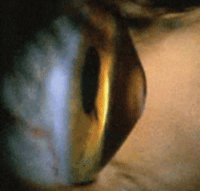Optometrists may one day be able to identify patients at high risk for glaucoma and keratoconus based on their genetic profiles, thanks to a discovery by scientists at the Singapore Eye Research Institute and the Association for Science, Technology and Research’s Genome Institute of Singapore.

Certain corneal thickness genes confer an increased risk for keratoconus.
The team identified genes for central corneal thickness (CCT) associated with potentially blinding conditions, including glaucoma and keratoconus. With an estimated heritability of up to 95%, CCT may determine the severity of one’s glaucoma and assist ODs in identifying patients with high risk for progression.
The authors identified a total of 26 CCT-associated genetic loci, including six for keratoconus. Their multicenter study involved 55 hospitals and research centers across the globe, and they performed a meta-analysis on data from more than 20,000 individuals in European and Asian populations.
“This paper identified six novel genetic variants that confer increased risk of keratoconus, a condition for which genes were not very forthcoming prior to this study,” says co-author Eranga Vithana, PhD, associate professor and associate director of Basic and Experimental Sciences at Singapore Eye Research Institute. “It once again underlined the inevitability of large scale collaborative studies to unravel genes for common complex diseases and also the advantage of having well-characterized large cohorts.”
Yi L, Vitart V, Burdon KP, et al. Genome-wide association analyses identify multiple loci associated with central corneal thickness and keratoconus. Nat Genet. 2013 Feb;45(2):155-63.

